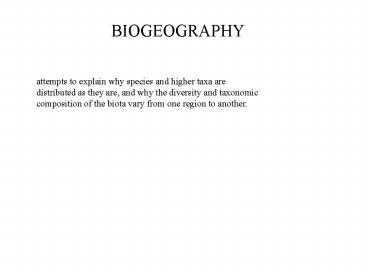BIOGEOGRAPHY PowerPoint PPT Presentation
Title: BIOGEOGRAPHY
1
BIOGEOGRAPHY
attempts to explain why species and higher taxa
are distributed as they are, and why the
diversity and taxonomic composition of the biota
vary from one region to another.
2
INTEGRATION OF SEVERAL DISCIPLINES
- Geology
3
INTEGRATION OF SEVERAL DISCIPLINES
- Geology
Triassic
Cretaceous
Oligocene
Paleocene
4
INTEGRATION OF SEVERAL DISCIPLINES
- Geology
- Paleontology
5
INTEGRATION OF SEVERAL DISCIPLINES
- Geology
- Paleontology
- Phylogenetics
6
INTEGRATION OF SEVERAL DISCIPLINES
- Geology
- Paleontology
- Phylogenetics
Gila Monster (Heloderma)
Lanthanotus thought to be related to Gila
monsters (weird distribution). It is really
related to Monitor lizards (makes sense for
biogeography).
Monitor Lizard (Varanidae)
7
INTEGRATION OF SEVERAL DISCIPLINES
- Geology
- Paleontology
- Phylogenetics
- Ecology
8
AN EXAMPLE OF BIOGEOGRAPHIC AREAS
Philip Sclater (1829-1913)
Wallaces Line
9
BIOREGIONS AT VARIOUS SPATIAL SCALES
10
AN EXAMPLE OF BIOGEOGRAPHIC AREAS
Wallaces Line
11
CHARLES R. DARWIN
- Neither the similarity or dissimilarity
- of the inhabitants of various regions can
- be wholly accounted for by climatic
- and other physical conditions.
12
CHARLES R. DARWIN
- Barriers of any kindare related in a close
- and important manner to the differences
- between the productions organisms of
- various regions
13
FACTORS AFFECTING GEOGRAPHIC DISTRIBUTIONS
(what might increase a species range?)
BIOTIC
- Adaptation to new conditions
- Dispersal through continuous habitat
- Jump Dispersal across a major barrier (sea
- mountain, etc.)
14
FACTORS AFFECTING GEOGRAPHIC DISTRIBUTIONS
(what might increase a species range?)
ABIOTIC
- Climatic Regime change
- Eustatic Events (change in sea level-provides
bridges) - Tectonic Events (plate movements mountains, etc.)
15
DISPERSAL VS. VICARIANCE HYPOTHESESES
- Dispersal Hypothesis
- Taxon originated in one area
- and dispersed to the other
- Vicariance Hypothesis
- Areas were formerly contiguous,
- and were occupied by the ancestor.
- Species differentiated after barrier
- arose.
16
MARSUPIAL EXAMPLE
AREA CLADOGRAMS
17
CONGRUENT BIOGEOGRAPHIES (Comparative
Phylogeography)
18
(No Transcript)
19
(No Transcript)
20
(No Transcript)
21
ECOLOGY (ESSENTIAL)
A species cannot survive outside of its
physiological tolerance range its biogeography
cannot contradict its ecology.
22
ECOLOGY (ESSENTIAL)
A species cannot survive outside of its
physiological tolerance range its biogeography
cannot contradict its ecology.
Are Ecological and Historical Factors
Alternatives?
23
DETERMINING IF ECOLOGY OR HISTORY IS MORE
IMPORTANT
end of distribution
end of distribution
A
A
Same environment Different environment
24
DETERMINING IF ECOLOGY OR HISTORY IS MORE
IMPORTANT
Different (A could not occur)
Same environment (A could occur)
end of distribution
end of distribution
A
A
Same environment Different environment
25
DETERMINING IF ECOLOGY OR HISTORY IS MORE
IMPORTANT
History (Barrier existed)
Ecology
end of distribution
end of distribution
A
A
Same environment Different environment
26
Taricha torosa Mitochondrial Lineages
27
BIOCLIMATIC MODELING
(unique environmental space selection?)
28
SYTEMATISTS AND ECOLOGISTS ASK DIFFERENT QUESTIONS
- Systematists look first to evolutionary history
- Ecologists look first to physiological tolerances
and - species interactions
29
SYTEMATISTS AND ECOLOGISTS ASK DIFFERENT QUESTIONS
- Systematists look first to evolutionary history
- Ecologists look first to physiological tolerances
and - species interactions
30
MacArthur and Wilson 1967
Theory of Island Biogeography
Why do islands have fewer species than same area
on continent?
31
MacArthur and Wilson 1967
Theory of Island Biogeography
Why do islands have fewer species than same area
on continent?
Small islands have higher extinction
rates. Farther islands have lower probability of
immigration.
Function of SIZE of island and DISTANCE from
mainland
32
CHECKERBOARD DISTRIBUTIONS not all islands
have the predicted equilibrium number of species
(White-eyes in New Guinea)
Interspecific Competition (ecology) also
influences particular species distributions.
33
Placentals Marsupials
CONVERGENT EVOLUTION (form of homoplasy)
Are the same niches predictably occupied by
phylogenetically independent groups of organisms?
34
(No Transcript)

